Small Municipalities in the Amazon under the Risk of Future Climate Change
Abstract
:1. Introduction
2. Materials and Methods
0.1 (0.5 (MA + MC)) + 0.1 GP
3. Results and Discussion
4. Conclusions and Recommendation
- The curve of R of natural disasters throughout the territory of small municipalities in the Amazon will intensify significantly over the next two 25-year periods. Although there is a high intra-municipal spatial variation, the overall results of the highest proportions of R (total municipalities affected) by state indicate that for AM, RR, PA, and MA, the prevailing categories are high and very high in the near and far future. The state of AC prevails in the moderate category in both the future periods, and the states RO, MT and AP move from category very low to low in the near to the far future.
- The detailed assessment of component V allowed us to elucidate that the economy indicator is the most serious in the scope of susceptibility, followed by indicators portraying the precariousness of urban infrastructure (households with problems in the supply of potable water, waste disposal, and sanitary sewage). Likewise, health (low availability of medical beds and hospitals), digital communication (access to broadband internet), and urban mobility (public transport) indicators, whose services are the most used by the population in the face of a climate emergency, also contributed negatively to the unfavorable situation of municipal vulnerability. These combined factors, unfortunately, reveal a widespread poverty profile among the small Amazonian municipalities, highlighting the need for greater public investments.
Author Contributions
Funding
Data Availability Statement
Acknowledgments
Conflicts of Interest
Appendix A
| GCMs | Acronym | Country |
|---|---|---|
| 1 | ACCESS-CM2 | Australia |
| 2 | ACCESS-ESM1-5 | Australia |
| 3 | BCC-CSM2-MR | China |
| 4 | CNRM-CM6-1-HR | France |
| 5 | CNRM-CM6-1 | France |
| 6 | CNRM-ESM2-1 | France |
| 7 | CanESM5 | Canada |
| 8 | EC-Earth3-Veg | Europe |
| 9 | EC-Earth3 | Europe |
| 10 | GFDL-CM4 | USA |
| 11 | GFDL-ESM4 | USA |
| 12 | HadGEM3-GC31-LL | UK |
| 13 | INM-CM4-8 | Russia |
| 14 | INM-CM5-0 | Russia |
| 15 | KACE-1-0-G | Korea |
| 16 | KIOST-ESM | Korea |
| 17 | MIROC-ES2L | Japan |
| 18 | MIROC6 | Japan |
| 19 | MPI-ESM1-2-HR | Germany |
| 20 | MPI-ESM1-2-LR | Germany |
| 21 | MRI-ESM2-0 | Japan |
| 22 | NESM3 | China |
| 23 | NorESM2-MM | Norway |
| 24 | UKESM1-0-LL | UK |
| Near-Future (2015 to 2039) | Far-Future (2040 to 2064) | |||||||||||||||||||
|---|---|---|---|---|---|---|---|---|---|---|---|---|---|---|---|---|---|---|---|---|
| SSP2-4.5 | SSP5-8.5 | SSP2-4.5 | SSP5-8.5 | |||||||||||||||||
| Very High | High | Moderate | Low | Very Low | Very High | High | Moderate | Low | Very Low | Very High | High | Moderate | Low | Very Low | Very High | High | Moderate | Low | Very Low | |
| AC | 15% | 10% | 50% | 20% | 5% | 15% | 35% | 35% | 15% | 0% | 10% | 15% | 40% | 30% | 5% | 15% | 40% | 30% | 15% | 0% |
| AM | 20% | 32% | 30% | 18% | 0% | 32% | 32% | 28% | 8% | 0% | 20% | 28% | 30% | 22% | 0% | 34% | 32% | 32% | 2% | 0% |
| AP | 7% | 7% | 14% | 29% | 43% | 14% | 7% | 21% | 29% | 29% | 0% | 14% | 14% | 29% | 43% | 14% | 7% | 21% | 29% | 29% |
| MA | 20% | 27% | 30% | 16% | 6% | 31% | 29% | 23% | 15% | 2% | 17% | 28% | 29% | 20% | 6% | 36% | 26% | 21% | 15% | 2% |
| MT | 10% | 10% | 20% | 24% | 35% | 15% | 9% | 24% | 24% | 28% | 8% | 13% | 19% | 25% | 36% | 17% | 9% | 29% | 21% | 25% |
| PA | 33% | 37% | 15% | 11% | 4% | 53% | 26% | 11% | 9% | 1% | 29% | 37% | 19% | 11% | 4% | 55% | 25% | 10% | 9% | 1% |
| RO | 11% | 16% | 16% | 27% | 31% | 18% | 20% | 11% | 27% | 24% | 7% | 20% | 13% | 27% | 33% | 20% | 17% | 18% | 24% | 21% |
| RR | 7% | 43% | 21% | 29% | 0% | 36% | 29% | 7% | 29% | 0% | 7% | 43% | 21% | 29% | 0% | 35% | 37% | 7% | 21% | 0% |
| TO | 3% | 5% | 11% | 26% | 54% | 6% | 7% | 12% | 31% | 43% | 2% | 5% | 12% | 24% | 57% | 7% | 8% | 12% | 32% | 41% |
References
- Trenberth, K.; Fasullo, J.; Shepherd, T. Attribution of climate extreme events. Nat. Clim. Chang. 2015, 5, 725–730. [Google Scholar] [CrossRef]
- Vogel, M.; Hauser, M.; Seneviratne, S. Projected changes in hot, dry and wet extreme events’ clusters in CMIP6 multi-model ensemble. Environ. Res. Lett. 2020, 15, 094021. [Google Scholar] [CrossRef]
- Gu, L.; Chen, J.; Yin, J.; Slater, L.J.; Wang, H.M.; Guo, Q.; Feng, M.; Qin, H.; Zhao, T. Global increases in compound flood-hot extreme hazards under climate warming. Geophys. Res. Lett. 2022, 49, e2022GL097726. [Google Scholar] [CrossRef]
- Zhou, S.; Yu, B.; Zhang, Y. Global concurrent climate extremes exacerbated by anthropogenic climate change. Sci. Adv. 2023, 9, eabo1638. [Google Scholar] [CrossRef]
- IPCC. Managing the Risks of Extreme Events and Disasters to Advance Climate Change Adaptation. A Special Report of Working Groups I and II of the Intergovernmental Panel on Climate Change; Field, C.B., Barros, V., Stocker, T.F., Qin, D., Dokken, D.J., Ebi, K.L., Mastrandrea, M.D., Mach, K.J., Plattner, G.-K., Allen, S.K., et al., Eds.; Cambridge University Press: Cambridge, UK; New York, NY, USA, 2012; p. 582. [Google Scholar]
- Hummell, B.M.L.; Cutter, S.L.; Emrich, C.T. Social Vulnerability to Natural Hazards in Brazil. Int. J. Disaster Risk Sci. 2016, 7, 111–122. [Google Scholar] [CrossRef]
- Reboita, M.S.; Kuki, C.A.C.; Marrafon, V.H. South America climate change revealed through climate indices projected by GCMs and Eta-RCM ensembles. Clim. Dyn. 2022, 58, 459–485. [Google Scholar] [CrossRef]
- Vieira, R.M.d.S.P.; Sestini, M.F.; Tomasella, J.; Marchezini, V.; Pereira, G.R.; Barbosa, A.A.; Santos, F.C.; Rodriguez, D.A.; Nascimento, F.R.D.; Santana, M.O.; et al. Characterizing spatio-temporal patterns of social vulnerability to droughts, degradation and desertification in the Brazilian northeast. Environ. Sustain. Indic. 2020, 5, 100016. [Google Scholar] [CrossRef]
- Confalonieri, U.E.C.; Lima, A.C.L.; Brito, I.; Quintão, A.F. Social, environmental and health vulnerability to climate change in the Brazilian Northeastern Region. Clim. Chang. 2014, 127, 123–137. [Google Scholar] [CrossRef]
- Dobkowitz, S.; Walz, A.; Baroni, G.; Pérez-Marin, A.M. Cross-Scale Vulnerability Assessment for Smallholder Farming: A Case Study from the Northeast of Brazil. Sustainability 2020, 12, 3787. [Google Scholar] [CrossRef]
- Marengo, J.A.; Torres, R.R.; Alves, L.M. Drought in Northeast Brazil—Past, present, and future. Theor. Appl. Climatol. 2017, 129, 1189–1200. [Google Scholar] [CrossRef]
- Zeng, N.; Yoon, J.-H.; Marengo, J.A.; Subramaniam, A.; Nobre, C.A.; Mariotti, A.; Neelin, J.D. Causes and impacts of the 2005 amazon drought. Environ. Res. Lett. 2008, 3, 014002. [Google Scholar] [CrossRef]
- Marengo, J.A.; Tomasella, J.; Alves, L.M.; Soares, W.R.; Rodriguez, D.A. The drought of 2010 in the context of historical droughts in the amazon region. Geophys. Res. Lett. 2011, 38, L12703. [Google Scholar] [CrossRef]
- Correa, S.H.; Paiva, R.C.D.; Espinoza, J.C.; Collischonn, W. Multi-decadal Hydrological Retrospective: Case study of Amazon floods and droughts. J. Hydrol. 2017, 549, 667–684. [Google Scholar] [CrossRef]
- Satyamurty, P.; Costa, C.P.W.; Manzi, A.O.; Candido, L.A. A quick look at the 2012 record flood in the Amazon basin. Geophys. Res. Lett. 2013, 40, 1396–1401. [Google Scholar] [CrossRef]
- Towner, J.; Cloke, H.L.; Lavado, W.; Santini, W.; Bazo, J.; de Perez, E.C.; Stephens, E.M. Attribution of Amazon floods to modes of climate variability: A review. Meteorol. Appl. 2020, 27, e1949. [Google Scholar] [CrossRef]
- Espinoza, J.C.; Marengo, J.; Schongart, J.; Jimenez, J.C. The new historical flood of 2021 in the Amazon River compared to major floods of the 21st century: Atmospheric features in the context of the intensification of floods. Weather. Clim. Extrem. 2022, 35, 100406. [Google Scholar] [CrossRef]
- Mansur, A.V.; Brondízio, E.S.; Roy, S.; Hetrick, S.; Vogt, N.D.; Newton, A. An assessment of urban vulnerability in the Amazon Delta and Estuary: A multi-criterion index of flood exposure, socio-economic conditions and infrastructure. Sustain. Sci. 2016, 11, 625–643. [Google Scholar] [CrossRef]
- Almeida, L.Q.; Welle, T.; Birkmann, J. Disaster risk indicators in Brazil: A proposal based on the world risk index. Int. J. Disaster Risk Reduct. 2016, 17, 251–272. [Google Scholar] [CrossRef]
- IBGE—Instituto Brasileiro de Geografia e Estatística. Censo Demográfico 2022; IBGE: Brasília, Brazil, 2023. Available online: https://sidra.ibge.gov.br/pesquisa/censo-demografico/demografico-2022 (accessed on 1 December 2023).
- Eyring, V.; Bony, S.; Meehl, G.A.; Senior, C.A.; Stevens, B.; Stouffer, R.J.; Taylor, K.E. Overview of the Coupled Model Inter-comparison Project Phase 6 (CMIP6) experimental design and organization. Geosci. Model. Dev. 2016, 9, 1937–1958. [Google Scholar] [CrossRef]
- Cutter, S.L.; Boruff, B.J.; Shirley, W.L. Social vulnerability to environmental hazards. Soc. Sci. Q. 2003, 84, 242–261. Available online: http://www.jstor.org/stable/42955868 (accessed on 11 December 2023). [CrossRef]
- AdaptaBrasil, 2022. Documento Teórico-Metodológico Para Avaliação De Risco De Impacto De Mudança Climática Nos Setores Estratégicos De Recursos Hídricos E Segurança Alimentar da Plataforma AdaptaBrasil MCTI—Versão 1.1. Available online: https://adaptabrasil.mcti.gov.br/sobre/metodologia (accessed on 10 June 2022).
- Sandstad, M.; Schwingshackl, C.; Iles, C. Climate Extreme Indices and Heat Stress Indicators Derived from CMIP6 Global Climate Projections. Copernicus Climate Change Service (C3S) Climate Data Store (CDS). 2022. Available online: https://cds.climate.copernicus.eu/cdsapp#!/dataset/10.24381/cds.776e08bd?tab=overview (accessed on 10 November 2023).
- Funk, C.; Peterson, P.; Landsfeld, M.; Pedreros, D.; Verdin, J.; Shukla, S.; Husak, G.; Rowland, J.; Harrison, L.; Hoell, A.; et al. The climate hazards infrared precipitation with stations—A new environmental record for monitoring extremes. Sci. Data 2015, 2, 150066. [Google Scholar] [CrossRef]
- Chen, M.W.; Shi, P.; Xie, V.B.; Silva, V.E.; Kousky, R.; Higgins, W.; Janowiak, J.E. Assessing objective techniques for gauge-based analyses of global daily precipitation. J. Geophys. Res. 2008, 113, D04110. [Google Scholar] [CrossRef]
- Monteverde, C.; De Sales, F.; Jones, C. Evaluation of the CMIP6 Performance in Simulating Precipitation in the Amazon River Basin. Climate 2022, 10, 122. [Google Scholar] [CrossRef]
- Alexander, L.V.; Zhang, X.; Peterson, T.C.; Caesar, J.; Gleason, B.; Tank, A.M.G.K.; Haylock, M.; Collins, D.; Trewin, B.; Rahimzadeh, F.; et al. Global observed changes in daily climate extremes of temperature and precipitation. J. Geophys. Res. 2006, 111, D05109. [Google Scholar] [CrossRef]
- Taylor, K.E. Summarizing multiple aspects of model performance in a single diagram. J. Geophys. Res. 2001, 106, 7183–7192. [Google Scholar] [CrossRef]
- Medeiros, F.J.; Oliveira, C.P.; Diaz, A.A. Evaluation of extreme precipitation climate indices and their projected changes for Brazil: From CMIP3 to CMIP6. Weather. Clim. Extrem. 2022, 38, 100511. [Google Scholar] [CrossRef]
- Funatsu, B.M.; Le Roux, R.; Arvor, D.; Espinoza, J.C.; Claud, C.; Ronchail, J.; Michot, V.; Dubreuil, V. Assessing precipitation extremes (1981–2018) and deep convective activity (2002–2018) in the Amazon region with CHIRPS and AMSU data. Clim. Dyn. 2021, 57, 827–849. [Google Scholar] [CrossRef]
- Ferreira, G.W.d.S.; Reboita, M.S.; Ribeiro, J.G.M.; de Souza, C.A. Assessment of Precipitation and Hydrological Droughts in South America through Statistically Downscaled CMIP6 Projections. Climate 2023, 11, 166. [Google Scholar] [CrossRef]
- Debortoli, N.S.; Camarinha, P.I.M.; Marengo, J.A.; Rodrigues, R.R. An index of Brazil’s vulnerability to expected increases in natural flash flooding and landslide disasters in the context of climate change. Nat. Hazards 2017, 86, 557–582. [Google Scholar] [CrossRef]
- IPCC. Summary for Policymakers. In Climate Change 2023: Synthesis Report. Contribution of Working Groups I, II and III to the Sixth Assessment Report of the Intergovernmental Panel on Climate Change; Core Writing Team, Lee, H., Romero, J., Eds.; IPCC: Geneva, Switzerland, 2023; pp. 1–34. [Google Scholar] [CrossRef]
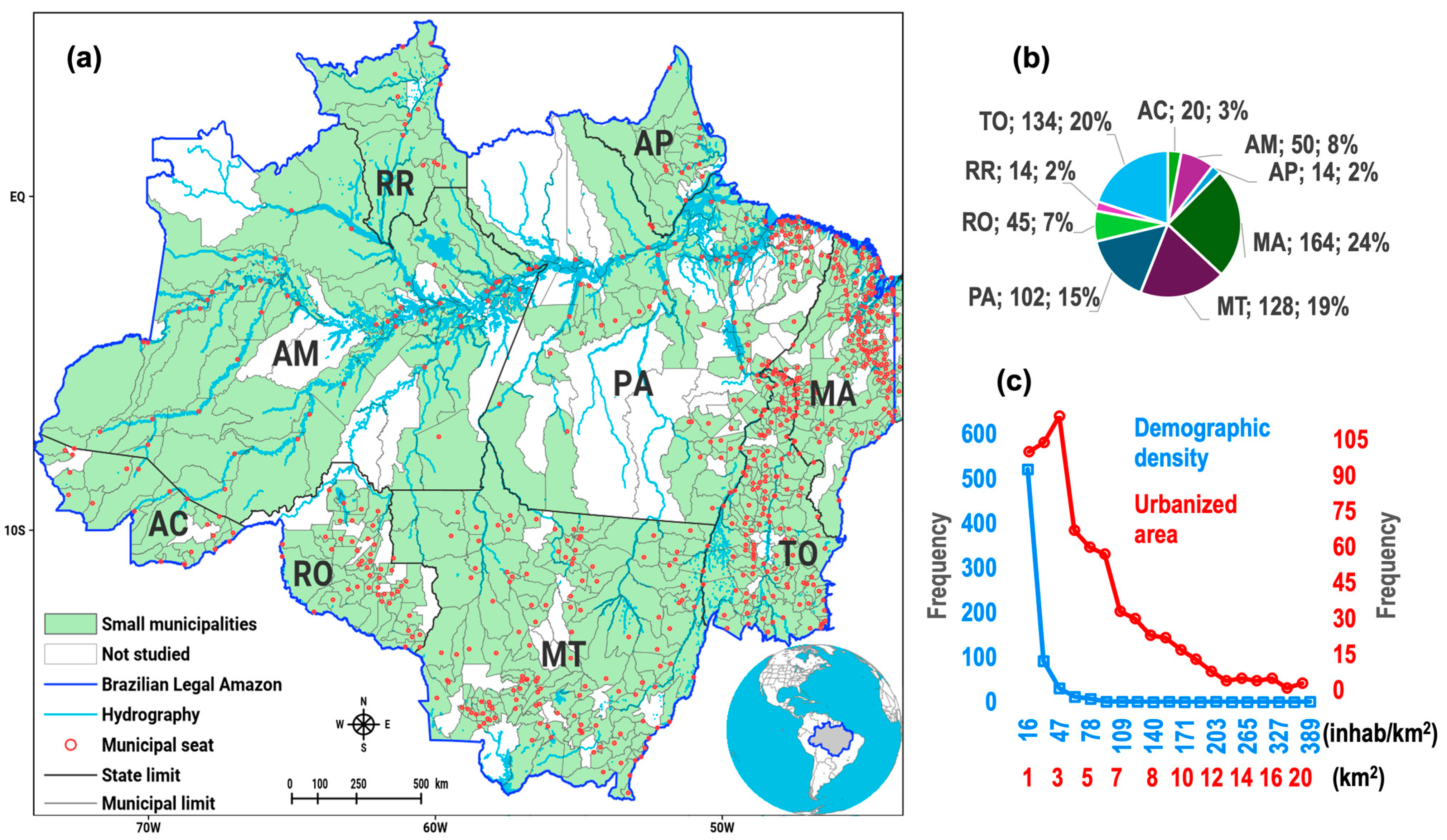
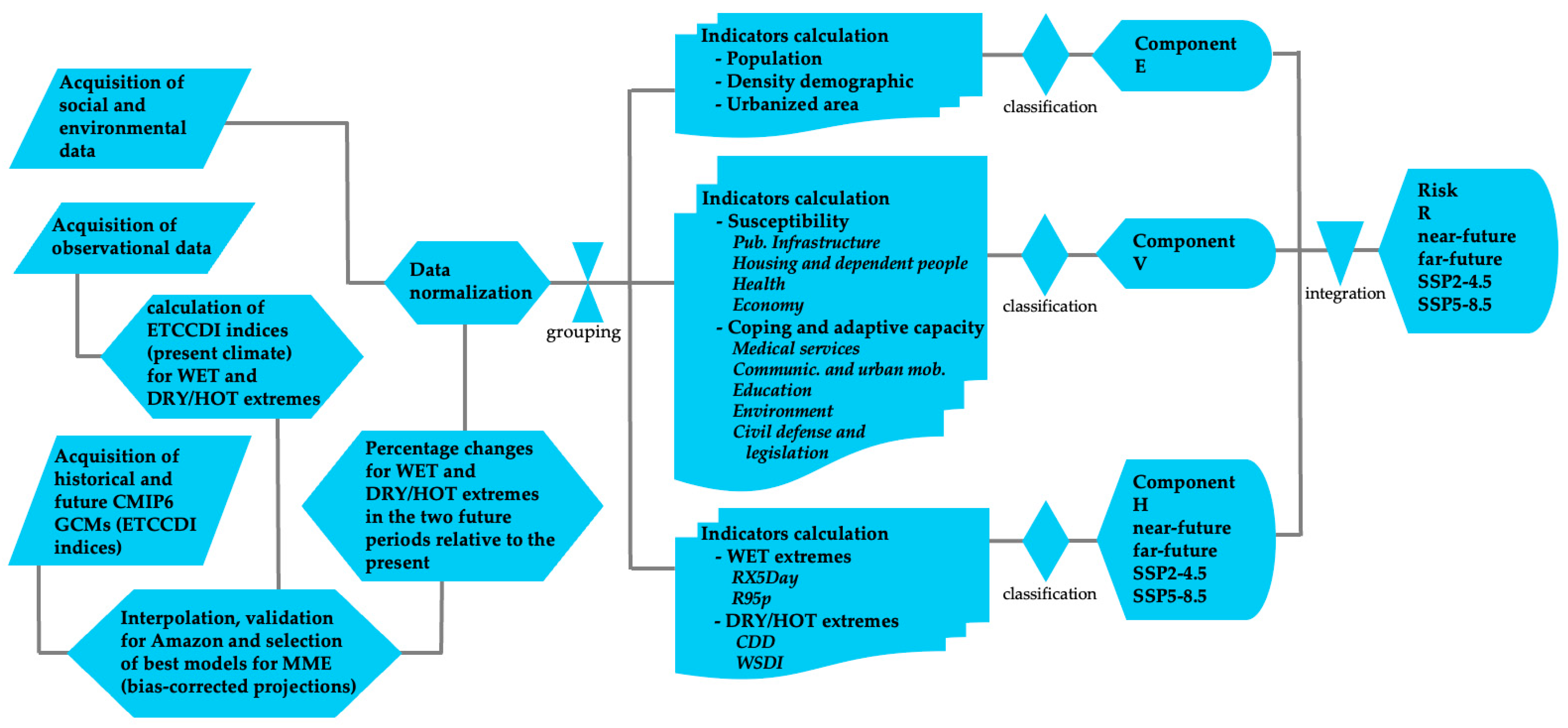
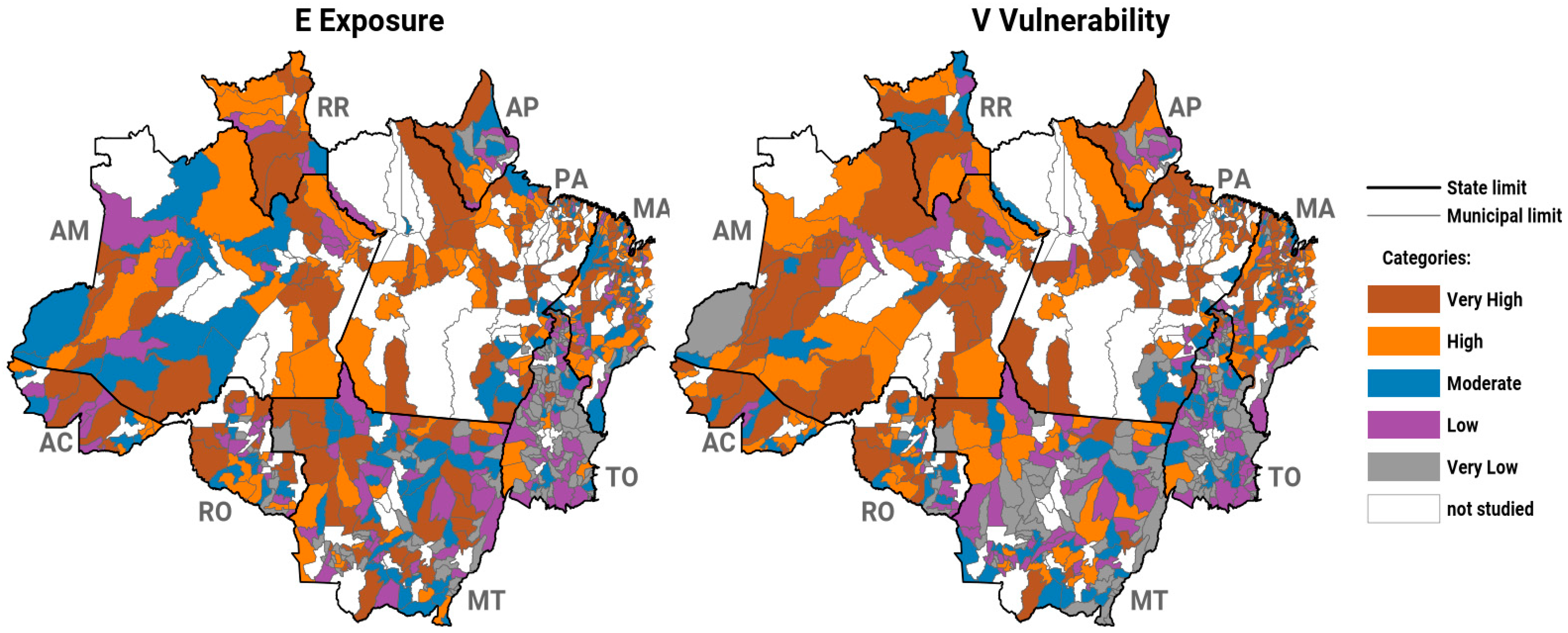
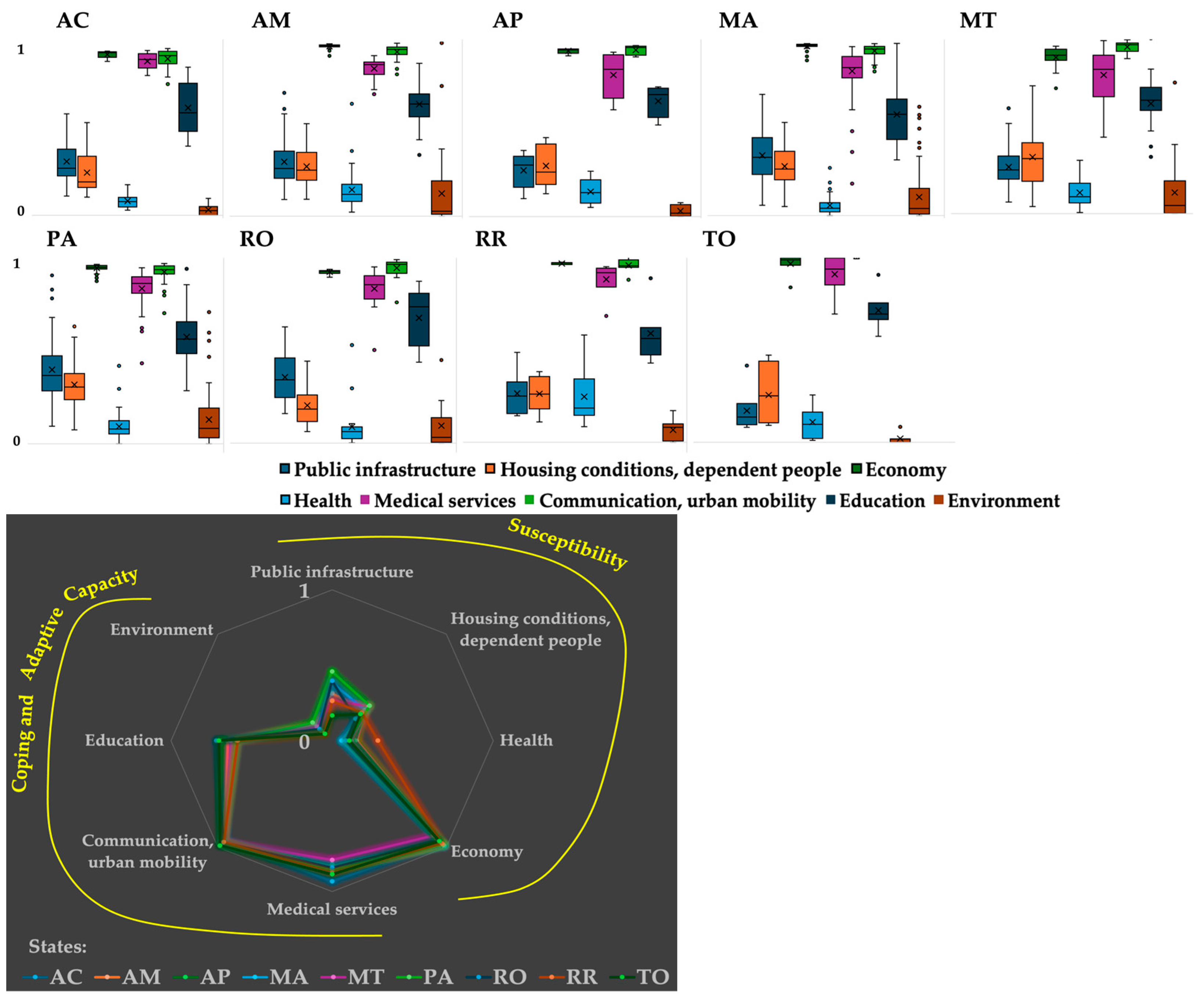
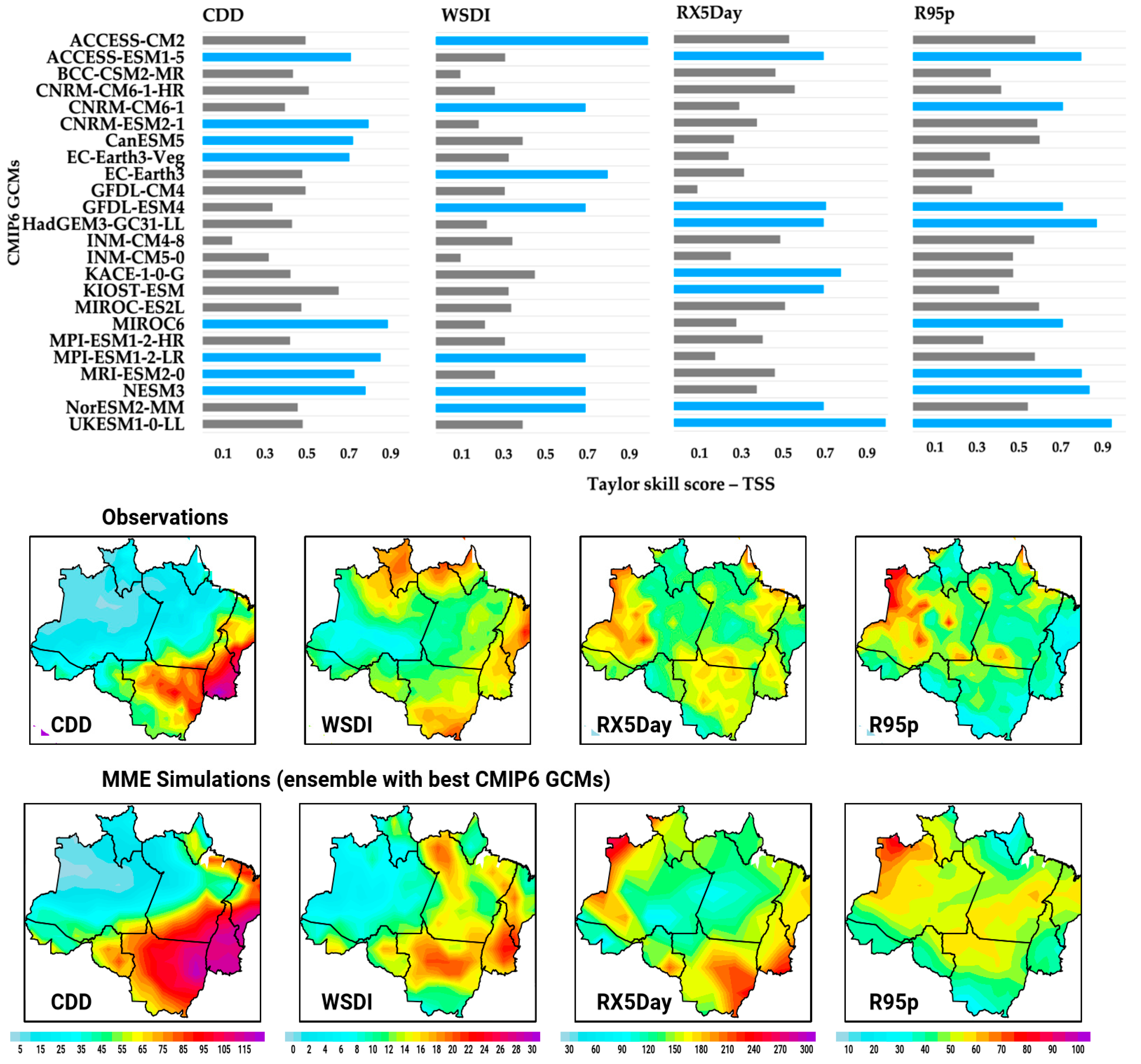
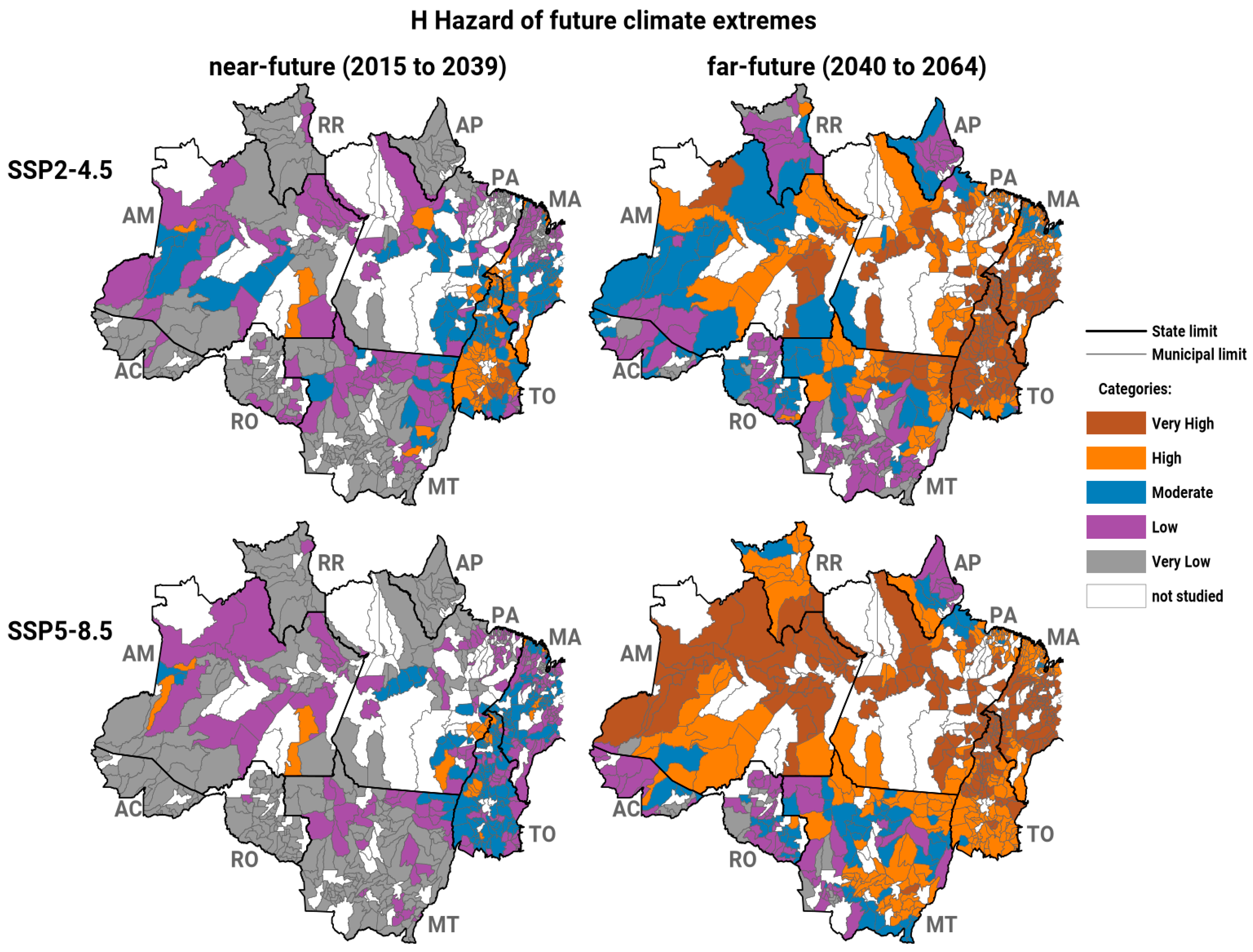

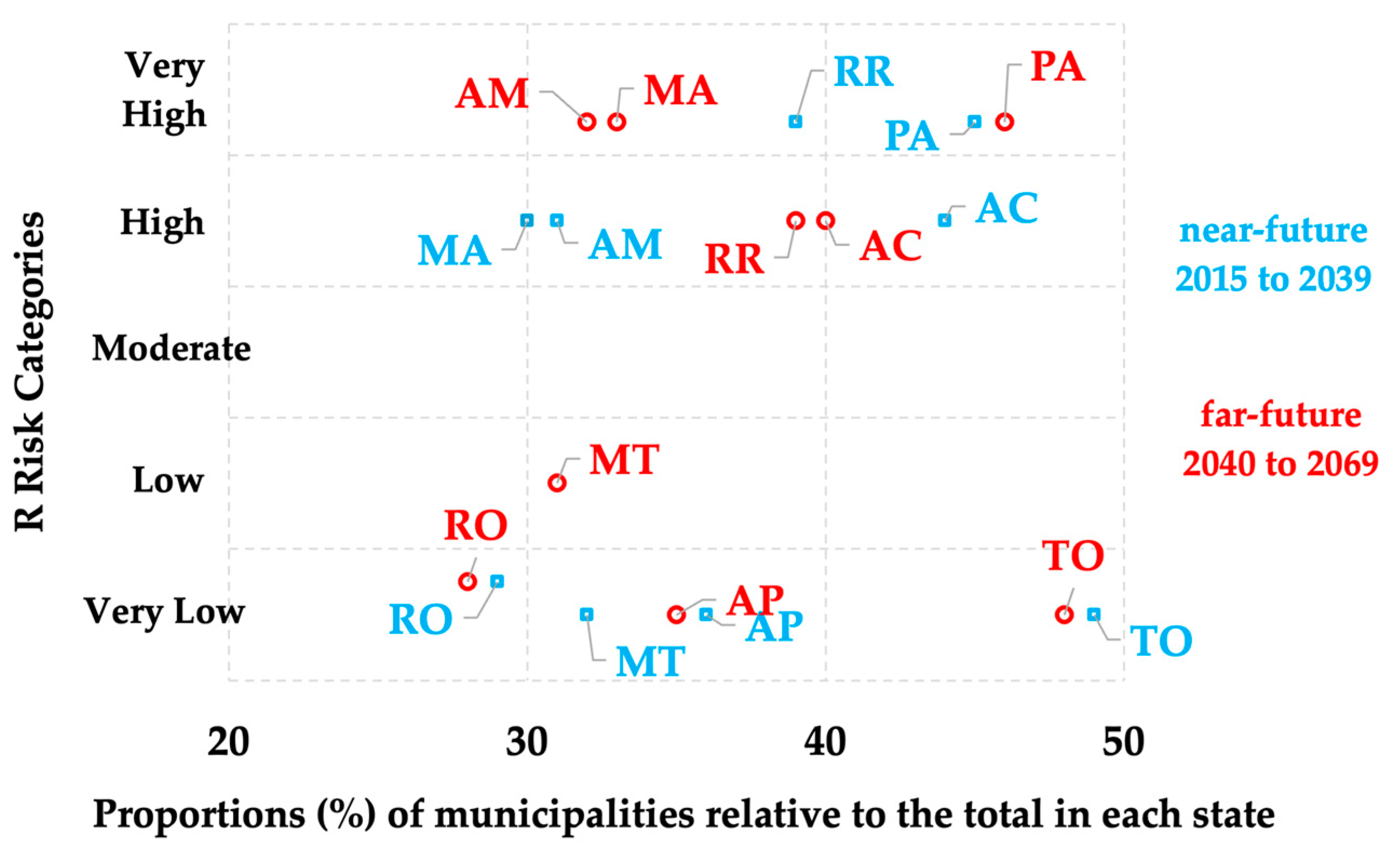
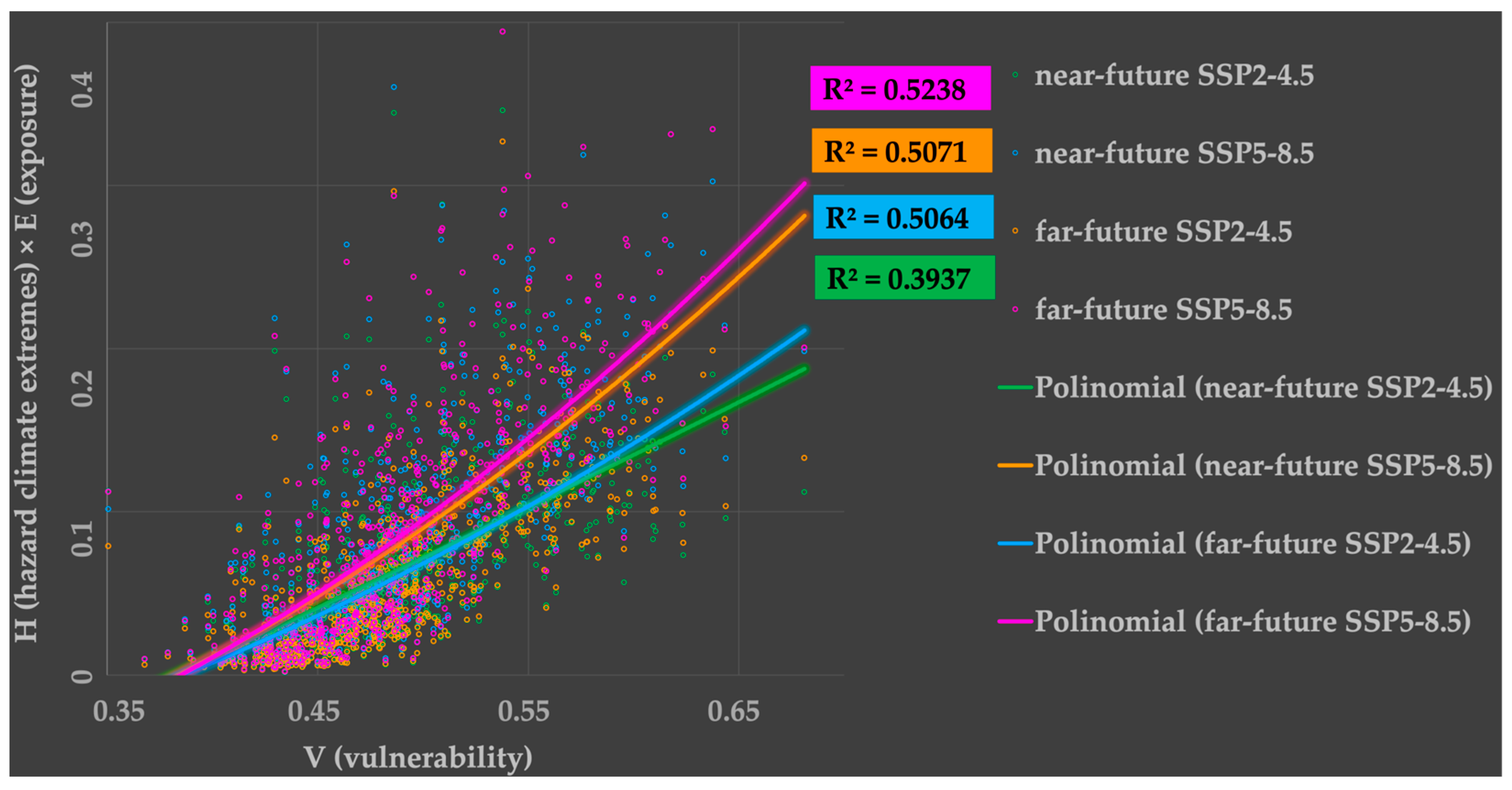

| Components, Sub-Dimensions, Themes, Variables/Indicators and Units | Acronym | Reference Year, Source |
|---|---|---|
| Component E | ||
| Total population (inhabitants) | TP | 2022, IBGE Census |
| Demographic density (inhabitants/km2) | DD | 2022, IBGE Census |
| Urbanized area (km2) | UA | 2019, IBGE |
| Component V | ||
| Sub-dimension S Susceptibility | ||
| Public infrastructure | ||
| Households by type of sewage system: rudimentary septic tank/hole, ditch, river, lake, stream or sea, without bathroom (total) | SW | 2022, IBGE Census |
| Households by type of waste destination: burned or buried on the property; played on vacant land or public area (total) | WD | 2022, IBGE Census |
| Households by form of water supply: no connection to general network (total) | WS | 2022, IBGE Census |
| Housing conditions and dependent people | ||
| Housing in a rooming house or tenement; residence unfinished (total) | HO | 2022, IBGE Census |
| Children 0 to 4 years (total) | CH | 2022, IBGE Census |
| Elderly people over 65 years old (total) | EL | 2022, IBGE Census |
| Health (illnesses and family losses) | ||
| Incidence of malaria | MA | 2018/2022, DATASUS |
| Mortality from COVID-19 (accumulated people) | MC | 2020/2021, DATASUS |
| Economy | ||
| GDP per capita (Thousand BRL/inhabitants) | GP | 2021, IBGE |
| C Coping/Adaptive Capacity | ||
| Medical services | ||
| Number of hospital beds (total) | HB | 2022, DATASUS |
| Number of physicians (total) | NP | 2022, DATASUS |
| Digital communication and urban mobility | ||
| Broadband Internet (access/100 homes) | BI | 2019, IBGE |
| Public transport (total buses/1000 inhabitants) | PT | 2019, IBGE |
| Education | ||
| IDEB Elementary Education—final years (concept) | ED | 2021, MEC/INEP |
| Environment | ||
| Accumulated deforestation (km2) | DE | 2000/2022, INPE |
| Existence of a civil defense department and specific legislation | ||
| Municipal civil defense coordination or secretariat or fire department (yes/no) | CD | 2019, IBGE |
| Public policy plan with municipal law instrument for planning and managing environmental disaster risks (yes/no) | IN | 2019, IBGE |
| Component H | ||
| Climate extremes associated with droughts and heat waves | ||
| Relative changes of CDD for near and far future | C_CDD | Future, CMIP6 GCMs |
| Relative changes of WSDI for near and far future | C_WSDI | Future, CMIP6 GCMs |
| Climate extremes associated with floods and inundations | ||
| Relative changes of R95p for near and far future | C_R95p | Future, CMIP6 GCMs |
| Relative changes of RX5day for near and far future | C_RX5day | Future, CMIP6 GCMs |
| E Exposure Categories | V Vulnerability Categories | |||||||||
|---|---|---|---|---|---|---|---|---|---|---|
| States | Very High | High | Moderate | Low | Very Low | Very High | High | Moderate | Low | Very Low |
| AC | 0.6% | 0.9% | 0.7% | 0.7% | 0.0% | 0.9% | 1.2% | 0.7% | 0.1% | 0.0% |
| AM | 1.9% | 2.1% | 2.4% | 1.0% | 0.0% | 3.0% | 2.5% | 1.0% | 0.7% | 0.1% |
| AP | 0.3% | 0.3% | 0.4% | 0.6% | 0.4% | 0.3% | 0.4% | 0.3% | 0.6% | 0.4% |
| MA | 5.4% | 7.0% | 6.3% | 4.8% | 1.0% | 6.0% | 5.8% | 7.3% | 3.9% | 1.5% |
| MT | 3.4% | 1.8% | 4.3% | 4.5% | 5.1% | 0.7% | 3.1% | 3.1% | 5.4% | 6.7% |
| PA | 6.4% | 4.6% | 2.5% | 1.3% | 0.3% | 7.3% | 3.6% | 2.5% | 1.2% | 0.6% |
| RO | 1.2% | 1.2% | 1.2% | 1.8% | 1.3% | 1.3% | 1.8% | 1.8% | 0.9% | 0.9% |
| RR | 0.7% | 0.7% | 0.1% | 0.4% | 0.0% | 0.6% | 0.4% | 0.6% | 0.4% | 0.0% |
| TO | 0.6% | 0.9% | 2.1% | 4.8% | 11.6% | 0.1% | 0.9% | 3.4% | 6.0% | 9.5% |
| State | Rank | Municipality | E × H | V | R | State | Rank | Municipality | E × H | V | R |
|---|---|---|---|---|---|---|---|---|---|---|---|
| AC | 1 | Tarauacá | 0.17 | 0.60 | 0.09 | AM | 1 | São Paulo de Olivença | 0.22 | 0.58 | 0.12 |
| 2 | Sena Madureira | 0.15 | 0.57 | 0.08 | 2 | Autazes | 0.26 | 0.61 | 0.11 | ||
| 3 | Feijó | 0.16 | 0.60 | 0.08 | 3 | Benjamin Constant | 0.18 | 0.57 | 0.11 | ||
| 4 | Senador Guiomard | 0.10 | 0.53 | 0.05 | 4 | Barreirinha | 0.16 | 0.59 | 0.11 | ||
| 5 | Mâncio Lima | 0.10 | 0.54 | 0.05 | 5 | Lábrea | 0.18 | 0.61 | 0.10 | ||
| 6 | Acrelândia | 0.08 | 0.50 | 0.04 | 6 | Presidente Figueiredo | 0.19 | 0.57 | 0.10 | ||
| 7 | Brasiléia | 0.08 | 0.49 | 0.04 | 7 | Boca do Acre | 0.19 | 0.57 | 0.09 | ||
| 8 | Porto Acre | 0.09 | 0.51 | 0.04 | 8 | Santo Antônio do Içá | 0.16 | 0.56 | 0.09 | ||
| 9 | Bujari | 0.09 | 0.50 | 0.04 | 9 | Borba | 0.17 | 0.61 | 0.09 | ||
| 10 | Marechal Thaumaturgo | 0.08 | 0.53 | 0.04 | 10 | Eirunepé | 0.16 | 0.57 | 0.08 | ||
| AP | 1 | Laranjal do Jari | 0.15 | 0.54 | 0.08 | MA | 1 | Raposa | 0.36 | 0.49 | 0.18 |
| 2 | Oiapoque | 0.14 | 0.55 | 0.07 | 2 | Presidente Dutra | 0.27 | 0.51 | 0.15 | ||
| 3 | Mazagão | 0.09 | 0.52 | 0.04 | 3 | Colinas | 0.25 | 0.54 | 0.14 | ||
| 4 | Porto Grande | 0.08 | 0.52 | 0.03 | 4 | Lago da Pedra | 0.25 | 0.55 | 0.13 | ||
| 5 | Vitória do Jari | 0.05 | 0.48 | 0.02 | 5 | São Bento | 0.21 | 0.60 | 0.13 | ||
| 6 | Calçoene | 0.05 | 0.50 | 0.02 | 6 | Vargem Grande | 0.22 | 0.60 | 0.13 | ||
| 7 | Tartarugalzinho | 0.05 | 0.47 | 0.02 | 7 | Zé Doca | 0.23 | 0.57 | 0.13 | ||
| 8 | Pedra Branca do Amapari | 0.04 | 0.47 | 0.02 | 8 | Cururupu | 0.22 | 0.47 | 0.13 | ||
| 9 | Ferreira Gomes | 0.03 | 0.45 | 0.01 | 9 | São Mateus do Maranhão | 0.23 | 0.54 | 0.13 | ||
| 10 | Amapá | 0.03 | 0.46 | 0.01 | 10 | São Domingos do Maranhão | 0.20 | 0.57 | 0.12 | ||
| MT | 1 | Juína | 0.29 | 0.51 | 0.17 | PA | 1 | Salinópolis | 0.41 | 0.54 | 0.22 |
| 2 | Confresa | 0.20 | 0.52 | 0.12 | 2 | Itupiranga | 0.26 | 0.62 | 0.16 | ||
| 3 | Juara | 0.22 | 0.51 | 0.12 | 3 | Conceição do Araguaia | 0.26 | 0.55 | 0.16 | ||
| 4 | Campo Novo do Parecis | 0.22 | 0.43 | 0.11 | 4 | Curuçá | 0.32 | 0.58 | 0.16 | ||
| 5 | Peixoto de Azevedo | 0.21 | 0.56 | 0.11 | 5 | Breu Branco | 0.28 | 0.62 | 0.16 | ||
| 6 | Campo Verde | 0.17 | 0.50 | 0.10 | 6 | Uruará | 0.30 | 0.64 | 0.15 | ||
| 7 | Água Boa | 0.18 | 0.46 | 0.10 | 7 | Jacundá | 0.28 | 0.54 | 0.15 | ||
| 8 | Guarantã do Norte | 0.20 | 0.51 | 0.10 | 8 | Augusto Corrêa | 0.24 | 0.53 | 0.14 | ||
| 9 | Nova Xavantina | 0.17 | 0.55 | 0.09 | 9 | Tucumã | 0.24 | 0.55 | 0.14 | ||
| 10 | Canarana | 0.16 | 0.49 | 0.09 | 10 | Pacajá | 0.26 | 0.63 | 0.13 | ||
| RO | 1 | Guajará-Mirim | 0.20 | 0.54 | 0.12 | RR | 1 | Rorainópolis | 0.17 | 0.51 | 0.09 |
| 2 | Pimenta Bueno | 0.17 | 0.49 | 0.10 | 2 | Normandia | 0.15 | 0.45 | 0.07 | ||
| 3 | Espigão D’Oeste | 0.15 | 0.56 | 0.09 | 3 | Alto Alegre | 0.11 | 0.61 | 0.07 | ||
| 4 | Machadinho D’Oeste | 0.14 | 0.54 | 0.08 | 4 | Cantá | 0.14 | 0.55 | 0.06 | ||
| 5 | Buritis | 0.17 | 0.54 | 0.08 | 5 | Caracaraí | 0.11 | 0.53 | 0.06 | ||
| 6 | Nova Mamoré | 0.14 | 0.56 | 0.08 | 6 | Pacaraima | 0.10 | 0.53 | 0.06 | ||
| 7 | Candeias do Jamari | 0.12 | 0.56 | 0.07 | 7 | Bonfim | 0.10 | 0.49 | 0.06 | ||
| 8 | Ouro Preto do Oeste | 0.13 | 0.48 | 0.07 | 8 | Uiramutã | 0.08 | 0.48 | 0.04 | ||
| 9 | Colorado do Oeste | 0.13 | 0.45 | 0.06 | 9 | Mucajaí | 0.08 | 0.49 | 0.04 | ||
| 10 | São Miguel do Guaporé | 0.11 | 0.56 | 0.05 | 10 | Amajari | 0.08 | 0.52 | 0.04 | ||
| TO | 1 | Araguatins | 0.22 | 0.56 | 0.13 | ||||||
| 2 | Colinas do Tocantins | 0.22 | 0.50 | 0.13 | |||||||
| 3 | Formoso do Araguaia | 0.15 | 0.52 | 0.09 | |||||||
| 4 | Guaraí | 0.15 | 0.48 | 0.08 | |||||||
| 5 | Tocantinópolis | 0.13 | 0.51 | 0.08 | |||||||
| 6 | Miracema do Tocantins | 0.12 | 0.47 | 0.07 | |||||||
| 7 | São Miguel do Tocantins | 0.13 | 0.48 | 0.07 | |||||||
| 8 | Lagoa da Confusão | 0.12 | 0.48 | 0.06 | |||||||
| 9 | Dianópolis | 0.11 | 0.45 | 0.06 | |||||||
| 10 | Augustinópolis | 0.10 | 0.35 | 0.05 |
Disclaimer/Publisher’s Note: The statements, opinions and data contained in all publications are solely those of the individual author(s) and contributor(s) and not of MDPI and/or the editor(s). MDPI and/or the editor(s) disclaim responsibility for any injury to people or property resulting from any ideas, methods, instructions or products referred to in the content. |
© 2024 by the authors. Licensee MDPI, Basel, Switzerland. This article is an open access article distributed under the terms and conditions of the Creative Commons Attribution (CC BY) license (https://creativecommons.org/licenses/by/4.0/).
Share and Cite
de Souza, E.B.; Silva, B.C.S.; Serra, E.M.F.; Ruiz, M.J.B.; Cunha, A.C.; Souza, P.J.P.O.; Pezzi, L.P.; da Rocha, E.J.P.; Sousa, A.M.L.; Silva, J.d.A., Jr.; et al. Small Municipalities in the Amazon under the Risk of Future Climate Change. Climate 2024, 12, 95. https://doi.org/10.3390/cli12070095
de Souza EB, Silva BCS, Serra EMF, Ruiz MJB, Cunha AC, Souza PJPO, Pezzi LP, da Rocha EJP, Sousa AML, Silva JdA Jr., et al. Small Municipalities in the Amazon under the Risk of Future Climate Change. Climate. 2024; 12(7):95. https://doi.org/10.3390/cli12070095
Chicago/Turabian Stylede Souza, Everaldo B., Brenda C. S. Silva, Emilene M. F. Serra, Melgris J. Becerra Ruiz, Alan C. Cunha, Paulo J. P. O. Souza, Luciano P. Pezzi, Edson J. P. da Rocha, Adriano M. L. Sousa, João de Athaydes Silva, Jr., and et al. 2024. "Small Municipalities in the Amazon under the Risk of Future Climate Change" Climate 12, no. 7: 95. https://doi.org/10.3390/cli12070095







